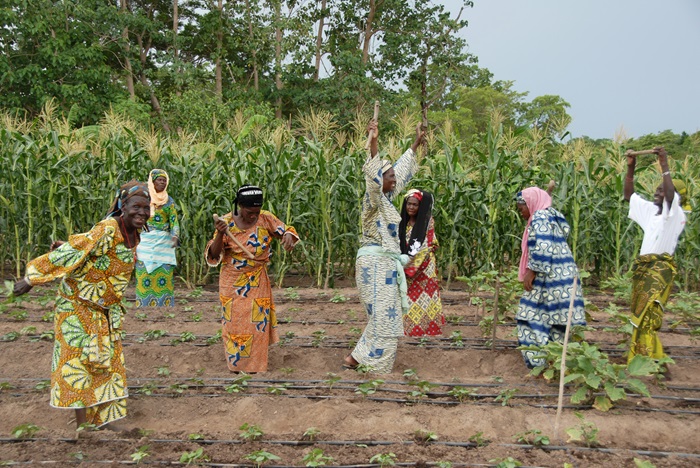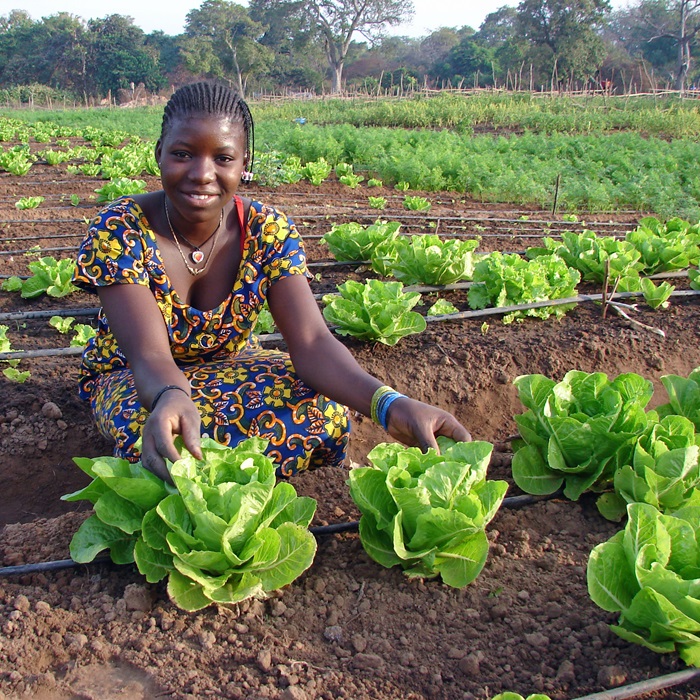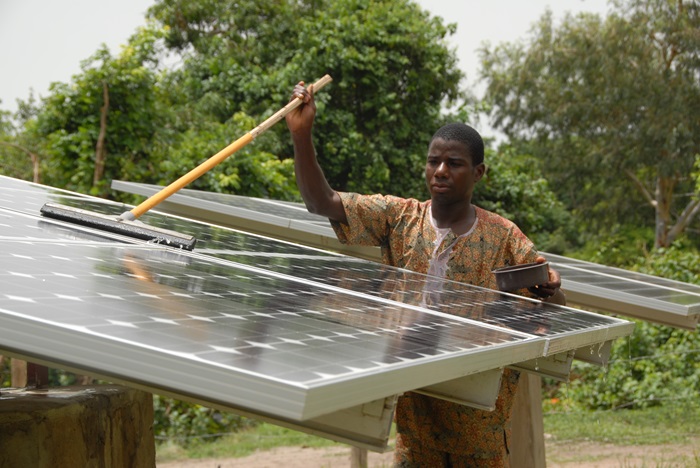By Robert A. Freling June 17, 2024

Women farmers from a cooperative in the village of Bessassi in northern Benin dance among their young crops, which are watered by solar-powered drip irrigation. (Credit: Solar Electric Light Fund)
Two billion people lack access to safe drinking water today.1 The impacts are dire — on human health, on food security, on gender equality, and more. When we look at who lacks clean water, the alignment with energy poverty is stark. It’s rural people, mostly (but not exclusively) in Sub-Saharan Africa.2
These patterns live on, not because we lack the technology, but because we continue to assume that large-scale solutions, whether the electric grid or conventional water systems, will someday reach these rural villages, given enough time. We need to think bigger — or rather, smaller. We need to embrace decentralized energy technologies. And the solar industry has an essential role to play.
First, what are the health consequences of relying on unsafe drinking water? Let’s look at some statistics. According to the Centers for Disease Control and Prevention, almost half a million children younger than five die each year from diarrhea worldwide, while another 95,000 people die from cholera and 129,000 die from typhoid fever. And 10 million people suffer from trachoma, a leading cause of blindness that stems from poor hygiene and sanitation.3
Worldwide, hundreds of millions of people are infected by parasitic worms that are typically associated with poor or nonexistent sanitation services. Millions suffer from Guinea worm disease, a nasty parasitic infection spread through dirty drinking water.4
These are just a few examples of the many ways in which unsafe water leads to human suffering.
Water insecurity, of course, also contributes to food insecurity. According to the World Bank, the number of people suffering from acute food insecurity rose from 135 million in 2019 to 345 million in mid-2022. The vast majority of these people live in rural parts of Sub-Saharan Africa, South Asia and Southeast Asia.5
It should come as no surprise that many of the people around the world suffering from water and food insecurity also lack access to basic electricity. I’ve certainly seen this correlation over the years in my own travels to off-grid villages in which the inability to reliably pump water for drinking and irrigation has led to chronically poor health and severely restricted diets.
There is growing recognition of the importance of energy access for human health. But awareness is only the first step toward solutions, and in this case, the best solution isn’t as simple as extending the grid.
The cost of grid extension varies, but where population density is low, so is the incentive for utilities to extend lines and connect communities. In countries with low electrification rates, governments are often already under financial strain, unable or unwilling to sponsor extension programs. As these economic and political challenges play out in the big cities, rural people are left in the dark.
But here’s the good news: Where the grid has either has failed or is nonexistent, new technologies are offering a path forward, and it’s small-scale solutions that are leading the way.

Finding new ways of generating clean, renewable power in remote, off-grid environments can often help rural communities both improve their access to safe drinking water and increase their agricultural productivity. This energy-water-food nexus presents an opportunity — or, one might argue, a responsibility — for solar innovators to step up to the plate.
And it’s already happening. A growing number of startups are developing novel applications of solar energy that are focused specifically on improving water access and boosting food production. And thanks to sunlight’s highly decentralized nature, these applications can be quickly deployed in rural settings that are not connected to national or regional utility grids.
The viability of a small-scale, decentralized approach to food and water security was proven back in 2006. In the Kalalé District of Benin, historical reliance on rain-fed agriculture led to widespread hunger and malnutrition during the six-month dry season.
Working with the people of Kalalé, the Solar Electric Light Fund (SELF), where I work, engineered a solution. SELF combined two technologies that had both been around for decades but were seldom used in tandem: solar water pumping and drip irrigation.
This simple but elegant solution, which SELF has dubbed the Solar Market Garden (SMG), empowered women farmers in the Kalalé District to grow highly nutritious produce year-round. Not only did local diets improve, but the women were also able to earn significant income for the first time in their lives through the sale of fresh produce to the local market.

In a report published in the Proceedings of the National Academy of Sciences, researchers at Stanford University concluded the SMG “significantly augments both household income and nutritional intake.”6
Today, in addition to solar-powered drip irrigation — which has become much more widespread over the past 15 years — another farming solution that holds great promise for enhancing food security is hydroponics.7
Like drip irrigation, hydroponics can be powered by solar, but unlike drip-irrigated farms, hydroponic systems offer the additional advantage of not being constrained by soil conditions, as they are typically set up in greenhouses that can be constructed almost anywhere.
Solar can also be instrumental in the preparation of food, with solutions like solar concentrating ovens and small solar-electric cookstoves, and in the storage of food, through solar fridges and walk-in cold rooms. Solar-driven applications can now power the entire food chain from production and processing to consumption and cold storage.
But back to water. When it comes to producing clean drinking water, once again, solar energy has a critical role to play. In addition to being used for conventional purification technologies such as reverse osmosis and filtration, solar is now helping to power the next generation of potable water solutions. Two examples come to mind.
One is a new class of “air-to-water” products that generate clean drinking water by extracting moisture directly from ambient air. Powered by solar energy, these products can be deployed and operated virtually anywhere in the world, in some cases even in dry desert environments with low humidity levels.
The second example, which recently emerged from a lab at the Massachusetts Institute of Technology (MIT), is a compact, portable desalination device that requires less electricity than a cell phone charger.
Whereas conventional desalination technology relies on reverse osmosis, this solar-powered device uses a small electric current that removes salt and bacteria from seawater as well as brackish water. MIT has spun off a company, NONA Technologies, to commercialize the technology.
As climate change intensifies, our water and food issues will get worse.8 Clean energy is part of the solution, not just as a mitigation tactic, but as an adaptation tactic too.
Modular solar-powered systems can meet rural people where they are. The solar industry has not only a moral imperative but also a unique business opportunity to integrate with new decentralized technologies to power our clean energy future. This can create lifesaving water and food solutions.
Conventional thinking won’t reach the last two billion. It’s time to be bold in pursuit of what will.

Sources
- http://tinyurl.com/44j74rbt
- https://tinyurl.com/yf7mnp2b
- http://tinyurl.com/44j74rbt
- Ibid.
- http://tinyurl.com/a3hmmyyw
- http://tinyurl.com/5xtezutb
- https://tinyurl.com/2z8dar5n
- https://tinyurl.com/2mjada7u
About the Author
Robert A. Freling is the executive director of the Solar Electric Light Fund. From Benin to Bhutan, he has traveled to some of the world’s most remote places, deploying solar-powered solutions for people living in energy poverty. He has advocated for universal energy access since 1995. He is an American Solar Energy Society member.



